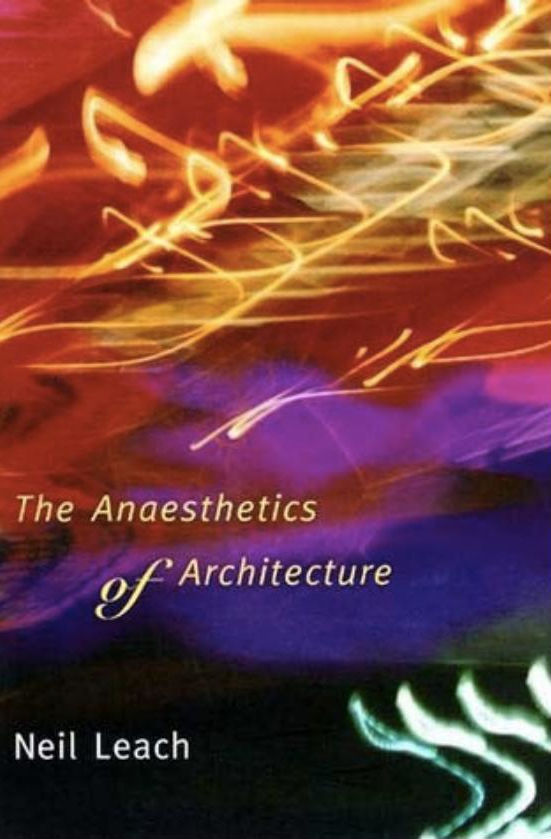
The Anaesthetics of Architecture (1999) Neil Leach
The Anaesthetics of Architecture is a polemical book where the author selects text and ideas from theorist such as Walter Benjamin and Jean Baudrillard, among others, to discuss the state of architectural culture at the turn of the century. The author states in the Preface:
“The premise behind the book is that architects have become increasingly obsessed with images and image-making, to the detriment of their profession. The sensory stimulation induced by these images may have a narcotic effect, which diminishes social and political awareness, leaving architects cossetted within their own aesthetic cocoons, remote from the actual concerns of everyday life. In the intoxicating world of the image, it is argued, the aesthetics of architecture threaten to become the anaesthetics of architecture. The intoxication of the aesthetic leads to an aesthetics of intoxication, and a consequent lowering of critical awareness. What results is a culture of mindless consumption, where there is no longer any possibility of meaningful discourse. In such a culture the only effective strategy is one of seduction, and architectural design is reduced to the superficial play of empty, seductive forms, and philosophy is appropriated as an intellectual veneer to justify these forms.” (pp. viii)
Leach argues that the over-emphasis on aestheticization1,2 of architecture in the modern world, an ‘architecture of depthless seductive images’, severs content from context.
“The world has become aestheticized and anaesthetized, and emptied of all content. And nowhere is this condition more marked, it would seem, than in the glossy pages of our architectural magazines, and in the fashion-conscious domains of our schools of architecture.” pp.34
Thus, architectural objects or concepts lose their historical and geographical specificity and identity.
“The problem here is that within the depthlessness of our current culture of the instantaneous, the significance of context is eroded. It is this very lack of any sense of context — of historical or geographic specificity …” pp.88
In architecture3, the aestheticization phenomenon could be considered as a way of distorting the reality if the aesthetic sensibilities of the architect prevail over the needs and/or perception of the populace.
“Architectural issues with important social and political ramifications are all too often decided on solely aesthetic grounds” … not only “within every fascist dictator there is a potential architect, but also that within every architect there is a potential fascist” pp.29
In what concerns the capacity for architecture to influence human behaviour, the author concludes that at best, it can provide spaces that might ‘invite’ certain spatial practices.4 Then, turning to the consumer of architecture, Leach points out that the perception depends on the viewer’s awareness. The author, discussing the effect of the overstimulation of the external world (the metropolitan world) on people – the blasé individual or the flâneur individual –, moves on to the power of images in the perceived world and in media. By analysing images from commercials, he argues that they have the power to “provide a form of ecstatic escapism” from to real world to other realms. Specifically, analysing the impact of architecture he states: “The glamorous world of the aesthetic environment of an architectural.office will provide you with an ecstatic experience comparable to drinking alcohol.”5 He identifies a loop. As our society is flooded with images (aestheticization), the intoxication will manifest in a decrease in our critical awareness, and eventually, when reaching a saturation point, an uncritical acceptance of the image – saturation, intoxication, complacency (permits additional saturation).
Regarding the 20th century architecture, the author turns to the Postmodernist architects Venturi, Scott Brown and Izenour and their book Learning from Las Vegas, criticizing their discourse about architectural aesthetics that supports “a culture of image … [for] a society where individuals are alienated from their true selves, and seduced instead by glamorous representations of their lives”6 for Leach considers that the authors appropriate architecture (specifically images of architecture) removed from social, historical, and geographical context, reuse it decontextualized and desemanticized in new places and then given new meaning.
Leach ventures further and signals that if we accept that content is not a property of form, it means that terms which represent the content of architecture, like concept or theory, can be detached from the initial context and the image, represented by the surface, can or will become the significant, ‘the object of desire’. The discussion is whether the only strategy for architecture in the contemporary world is the use of alluring images and shimmering effects, if the use of computers by students (and architects) facilitates de ‘production of seductive images’ void of content, if form for form’s sake still applies. If so, will the product be reconceptualized and its new concept will be absorbed by the contemporary culture dominated by simulation and hyperreality without any concern to the original meaning of the content?
“In an age obsessed with production, meaning has given way to technique and performativity. It is no longer a question of ‘why?’, but ‘how?’, and ‘how often?’.” pp.78
1 “Everything is transported into an aesthetic realm and valued for its appearance. The world has become aestheticized. Everything has become appropriated as art.” Leach, pp.7.
2 Leach quotes Baudrillard (1992, pp.10) “When everything becomes aesthetic, nothing is either beautiful or ugly anymore, and art itself disappears” pp.10.
3 Talking about the New Brutalist movement.
4 Leach, pp. 34
Ioana Mădălina Moldovan
Universitatea Tehnică din Cluj-Napoca
Leach, Neil. The Anaesthetics of Architecture. Massachusetts: MIT Press, 1999
